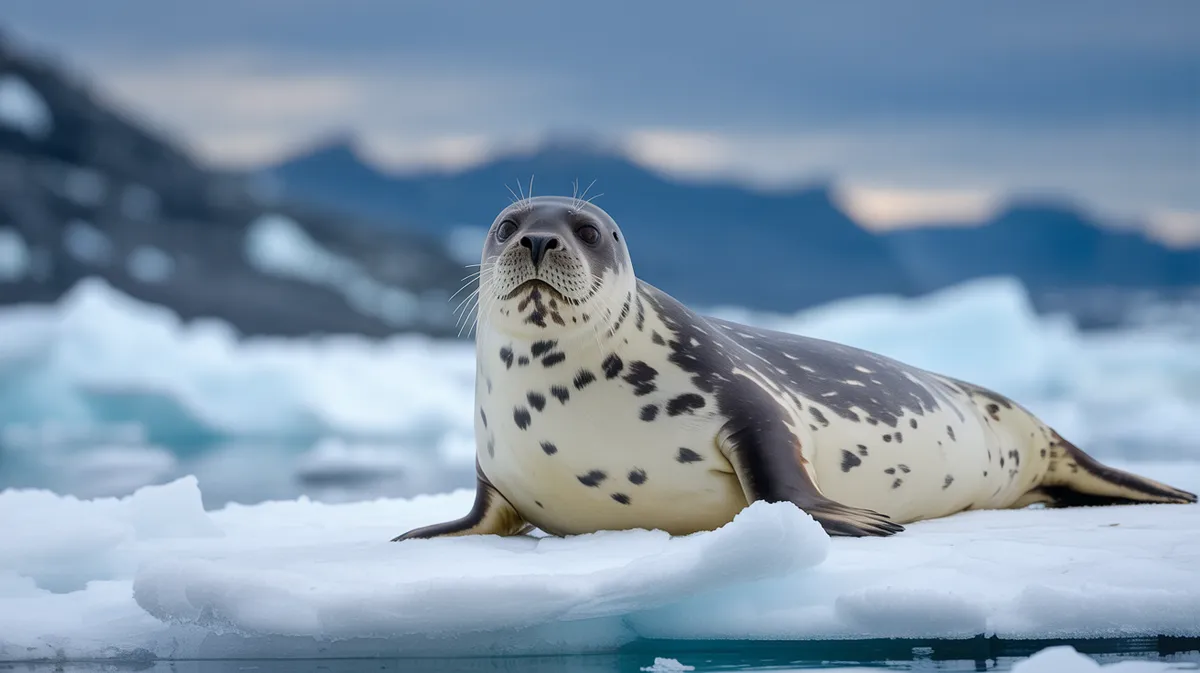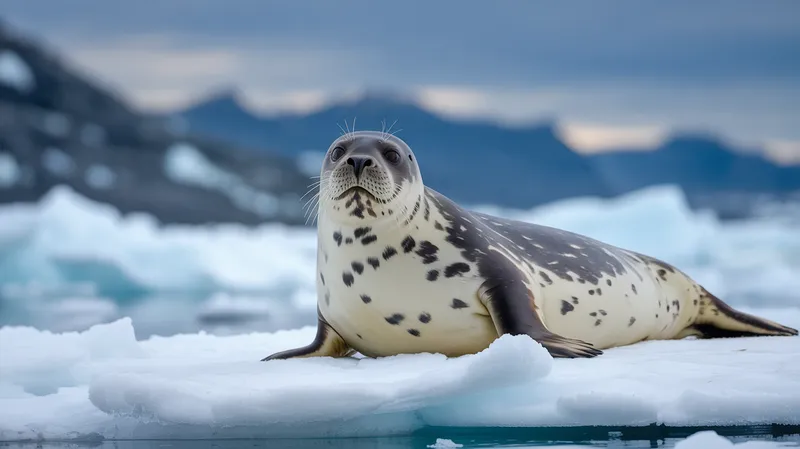
Hooded Seal
Cystophora cristata

Meet the Hooded Seal
The Hooded Seal is a large, striking seal native to the cold waters of the North Atlantic and Arctic Oceans. Named for the inflatable, hood-like nasal sac found in adult males, this unique structure is used for display during mating season and to ward off rivals. Hooded seals have a silvery-grey coat with irregular black spots and are known for their impressive diving abilities, often reaching depths of over 1,000 meters. Pups are born with a beautiful blue-gray fur, earning them the nickname 'bluebacks,' which they shed after a few weeks.
Classification
Mammal
Habitat
Arctic and subarctic oceanic pack ice
Diet
Carnivore
Lifespan
25-35 years
Conservation
Vulnerable
Weight
170–450 kg
📖Fascinating Facts
Inflatable Hood
Adult male hooded seals have a nasal sac that they can inflate into a large balloon over their head to display dominance and attract females.
Deep Divers
Hooded seals regularly dive to depths of 300–600 meters and have been recorded at depths exceeding 1,000 meters while hunting fish and squid.
Rapid Growth
Hooded seal pups nurse for only 3–5 days, during which they gain up to 7 kg per day from their mother’s fat-rich milk.
📋Detailed Description
The hooded seal (Cystophora cristata) is a robust, sexually dimorphic phocid distinguished by its unique inflatable nasal sac, or 'hood,' present in adult males. Males can reach lengths of 2.6 meters and weigh up to 400 kg, while females are smaller, averaging 2.2 meters and 300 kg. Their pelage is silver-grey to white, heavily mottled with irregular black spots, providing camouflage against the ice. The most striking feature is the male's nasal septum, which can be inflated into a balloon-like hood over the head, and a red nasal membrane that can be everted from one nostril, both used in visual and acoustic displays during social interactions. Hooded seals are highly adapted for deep diving, with the ability to reach depths exceeding 1,000 meters and remain submerged for over 15 minutes, facilitated by high blood volume and oxygen storage capacity. Their streamlined bodies and strong foreflippers enable agile swimming and rapid movement through the water. The species is generally solitary, except during the brief breeding season when they aggregate on pack ice. Pups, known as 'bluebacks,' are born with a distinctive blue-grey dorsal coat and creamy ventral fur, which they molt after 14 months. Hooded seals have a short lactation period—the shortest among mammals—lasting only 3–5 days, during which pups gain up to 7 kg per day from the rich, fatty milk. Their distribution is limited to the North Atlantic and adjacent Arctic Ocean, with four recognized breeding populations: the Northwest Atlantic (Gulf of St. Lawrence, Newfoundland), the Greenland Sea, the Davis Strait, and the White Sea.
💡 Did you know?
Hooded seal pups are weaned after just 3–5 days, the shortest lactation period of any mammal.
🔬Research & Sources
Wikipedia Summary
The hooded seal or bladdernose seal is a large phocid found only in the central and western North Atlantic, ranging from Svalbard in the east to the Gulf of St. Lawrence in the west. The seals are typically silver-grey or white in color, with black spots that vary in size covering most of the body. Hooded seal pups are known as "blue-backs" because their coats are blue-grey on the back with whitish bellies. This coat is shed after 14 months of age when the pups molt. It is the only species in the genus Cystophora.
Last Modified: 5/24/2025
🎭Behavior & Social Structure
Hooded seals are predominantly solitary outside the breeding and molting seasons, exhibiting minimal social interaction. They are highly migratory, undertaking long-distance movements between feeding and breeding grounds, often traversing thousands of kilometers annually. Their diet consists mainly of pelagic and benthic fish (such as Greenland halibut, redfish, and cod), squid, and crustaceans, with foraging occurring primarily at depth. They employ a combination of deep, prolonged dives and shorter, shallow dives, often foraging at night when prey is more accessible. Males are territorial during the breeding season, using their inflatable hood and nasal septum to produce visual and acoustic signals that deter rivals and attract females. Aggressive encounters between males can involve vocalizations, posturing, and physical confrontations. Resting occurs on pack ice, where individuals haul out to sleep, molt, or nurse pups. Outside of these periods, hooded seals spend most of their time at sea, rarely coming ashore.
👶Reproduction & Life Cycle
Breeding occurs from late March to early April, primarily on drifting pack ice. Hooded seals exhibit a polygynous mating system, with dominant males defending access to multiple females. Females give birth to a single pup after a gestation period of approximately 11.5 months, which includes a delayed implantation of the embryo for about 3–4 months. Pups are precocial, weighing 20–24 kg at birth and rapidly gaining weight due to the mother's milk, which contains up to 60% fat. Lactation is extremely brief (3–5 days), after which the female mates again and leaves the pup to fend for itself. Pups are weaned abruptly and must quickly learn to swim and hunt, facing high mortality rates in their first year. Sexual maturity is reached at 3–6 years for females and 5–7 years for males.
🛡️Adaptations & Survival
Hooded seals possess several remarkable adaptations for life in the harsh Arctic environment. Their thick blubber layer provides insulation and energy reserves during fasting periods. The male's inflatable hood and nasal septum are unique among pinnipeds, serving as both a visual and acoustic display to communicate dominance and fitness. Their large blood volume and high concentrations of myoglobin facilitate extended dives and efficient oxygen storage. The short, intense lactation period minimizes the time pups and mothers are exposed on vulnerable pack ice. Their cryptic coloration aids in camouflage from predators such as polar bears and killer whales. Seasonal migrations allow them to exploit variable food resources and avoid areas of heavy ice or human disturbance.
🎨Cultural Significance
Hooded seals have played a minor role in the traditional cultures of Arctic Indigenous peoples, who occasionally hunted them for meat, oil, and hides, though they were less targeted than harp seals. Their striking appearance and unique nasal hood have made them subjects of curiosity in natural history collections and scientific research. In modern times, they are sometimes featured in wildlife documentaries highlighting Arctic biodiversity and the impacts of climate change.
🔬Recent Research & Discoveries
Recent research has focused on the physiological mechanisms underlying the hooded seal's extreme diving abilities, including studies on oxygen storage, muscle biochemistry, and cardiovascular adaptations. Satellite telemetry has greatly improved understanding of migration patterns and habitat use, revealing extensive movements across the North Atlantic. Genetic studies have clarified population structure and connectivity between breeding sites. Ongoing research is assessing the impacts of climate change on breeding success and pup survival, as well as the accumulation of contaminants in tissues. The hooded seal's rapid pup development and brief lactation period continue to be of interest in comparative mammalian reproductive biology.
🎥Wildlife Videos

Hooded Seal | World's Weirdest
#NatGeoWILD #WorldsWeirdest #Seals About World's Weirdest: A buffalo with three eyes, an exterminator who eats his day's ...
Nat Geo Animals

Rare nature documentary from the 1980s - Hooded Seal
Fucking Lasso........ Well, I have had to remove the first 5 minutes of my original video due to a "claim" that honestly had no merit.
Andrew Warrick

Profiles of Nature: The Hooded Seal (full documentary)
Early 90's Discovery Channel VHS rip.
Forgotten Documentaries

Playground of the Seals | Free Documentary Nature
Playground of the Seals | Wildlife Documentary Some have called the coast of Brittany the Riviera of the North. The many coves ...
Free Documentary - Nature

"Mysteries Unveiled: Meet the Incredible Hooded Seal!"
Dive into the fascinating world of the mysterious Hooded Seal with us! Join us on an epic journey to uncover the secrets of one of ...
HOWIE580

Adult, Male Hooded Seal On Ice Inflates Hood Or Crest
Largest collection of Hooded Seal, Pinniped, Sexual Dimorphism stock video footage.
NatureFootage
🌍Habitat Information
The Hooded Seal typically inhabits Arctic and subarctic oceanic pack ice environments. Hooded Seals have adapted to their environments with specialized features and behaviors.
Primary Habitat:
Arctic and subarctic oceanic pack ice
More detailed habitat information will be available soon.
🛡️Conservation Status
The Hooded Seal is currently classified as Vulnerable. Conservation efforts are crucial for preserving this species for future generations.
Common Threats:
- 🏠Habitat loss and fragmentation
- 🌡️Climate change impacts
- 🎯Hunting and poaching
- 🏭Human-wildlife conflict
⚠️Threats & Conservation Challenges
The primary threats to hooded seals include climate change, which is rapidly reducing the extent and stability of pack ice necessary for breeding and molting. Bycatch in commercial fisheries, particularly in the North Atlantic, poses an additional risk. Historical commercial hunting for pelts, oil, and meat significantly reduced populations, though large-scale hunting has ceased in most regions. Pollution, especially accumulation of persistent organic pollutants (POPs) and heavy metals in Arctic food webs, may impact health and reproduction. The IUCN currently lists the species as Vulnerable, with some populations (notably the Northeast Atlantic stock) showing marked declines, while others remain stable or are recovering. Ongoing monitoring is essential due to the species' sensitivity to environmental change and low reproductive rates.
🔬Scientific Classification
Scientific Name
Cystophora cristata
Classification Hierarchy
🔍 About Taxonomic Classification
Taxonomic classification is a hierarchical system used by scientists to classify and organize living organisms based on shared characteristics and evolutionary relationships.
The system moves from broad categories (Kingdom) to increasingly specific ones, with each animal's scientific name typically consisting of its Genus and species.
📝Community Notes
Share your observations and insights about the Hooded Seal with our community of wildlife enthusiasts.
Join Our Community
Sign in to share your observations and connect with fellow wildlife enthusiasts.
Sign In to ContributeNo community notes yet
Be the first to share your observations about the Hooded Seal!
Explore Hooded Seal
Select a tab above to learn more about this amazing animal.
📸Photo Gallery
No photos available for this animal yet.
🌟Discover More Wildlife
Continue your journey of discovery with more fascinating animals from our database
